Questions and Answers: January 2015
This popular part of e-gardens is where Neil answers readers’ questions. Our template requires one or more photos for each question we post, so he cannot take questions that are sent without photos. He chooses questions that will appeal to the largest numbers of readers, so plant ID questions are probably better addressed by your local nurseryman. That said, here are his answers to this month’s questions.
Question: Most of our roses have acquired a disease I’ve not seen before. It starts with a red shoot that then grows rapidly and develops massive thorns. The leaves and flowers are deformed. Even our Tea roses have the disease. Any suggestions? L.H., Garland.
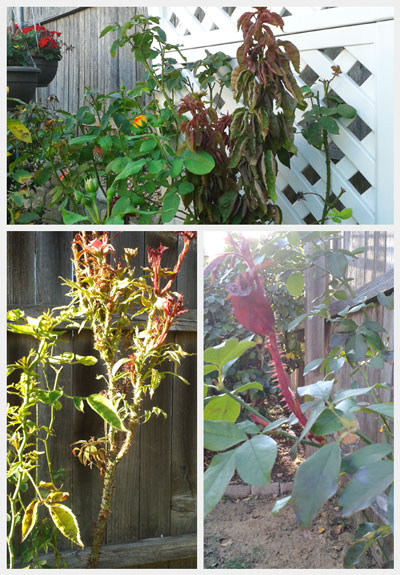
Answer: This is the fatal rose rosette virus that has been ravaging Metroplex roses for the past several years. Obviously, it has now arrived in your plantings. Afflicted plants should be dug and destroyed immediately. (Send to landfill in tied plastic trash bags.) It is spread by a microscopic mite for which we have no control, and the longer affected plants are left in place, the more widespread the virus will be.
It’s a bit of overkill, but here is text I posted on Facebook about 20 months ago, then again about eight months ago, in response to repeated questions about RRV. You’ll see that the experts are all in agreement.
“Garden Tip: It’s sad news when your rose bush develops strong bull canes or witches’ brooms of new growth that are covered with spines. That’s the fatal rose rosette virus, and it is becoming more and more common in Texas and America. It has probably spread to your plants from others in your neighborhood, carried by a tiny mite. Afflicted plants need to be removed entirely — roots, tops and all — and destroyed. Once you see rosette in real life, you’ll begin seeing it fairly commonly. This commercial landscaper needs to remove all plants that show any signs. There is no remedy.
As to replanting with new roses, in theory, if you removed all of the root system, you probably could, but I would be uncomfortable recommending that you do so in the same soil. I would suggest that you at least move to another part of your landscape.
Here are links that will shed light on the topic:
From the American Rose Society, a story that my friend the late Field Roebuck wrote more than a decade ago. (Excellent photographs.) http://www.ars.org/?page_id=3247
From Texas AgriLife Extension and my friend Dr. Mike Merchant http://citybugs.tamu.edu/2011/07/13/rose-rosette-disease-transmitted-by-a-mite/
Question: I had extensive foundation and plumbing repairs done on the side of my house. You can see the weak nandinas and dwarf yaupons in my photo. Several holes and tunnels were dug and roots of the pistachio trees were cut. Is it too cold to plant ryegrass now? Is there any way to prevent erosion should we get rain? It’s covered in jute landscape netting. S.A.S., Denton.

Answer: Your question was sent in early December, which would have been six or eight weeks late in sowing ryegrass anyway, so the added delay hasn’t set you back any further. The jute netting will probably suffice if you have it pegged down securely. You could also buy a few pieces of dormant St. Augustine and lay them across the slope to slow the flow of runoff. However, the closer you can get to March or early April, the better your chances of its surviving. It’s very difficult to get it to root and live when it’s planted in winter. It would be used simply to stop the runoff.
Question: My crape myrtles have these awful spider web nests in them. They were unsightly during the growing season, but they’re simply ugly now that the leaves have fallen. The plants are 20 to 25 feet tall. Should I have an arborist spray them next year? I saw them on other crape myrtles in our neighborhood, but a few miles away they aren’t present at all. What attracts them? E.G., Rockwall.
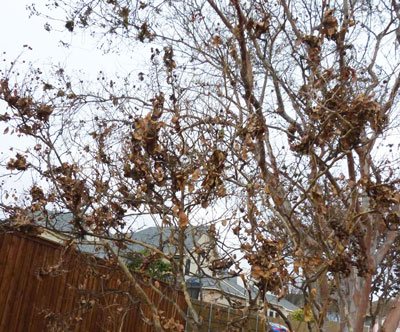
Answer: Crape myrtles have a couple of insects that will invade their leaf canopies, then secrete sticky honeydew residue on the leaves and stems. The spiders may be setting up camp going after them in some way, or they may be attracted to some other insect that gets on the plants. In either event, a systemic insecticide applied in late April or May should stop the insects and therefore the spiders. You could certainly hire an arborist, or you can buy hose-end sprayers that will reach to that height. Normally I discourage people from killing spiders outdoors, but in this case, I can see why you aren’t pleased to have them around.
Question: My big post oak is the main source of shade for our house, so I want to protect it. However, I planted ivy at its base seven years ago. The ivy has grown wild and now has vines a couple of inches in diameter. What can I use to kill the ivy that won’t hurt the post oak? P.H., no city given.
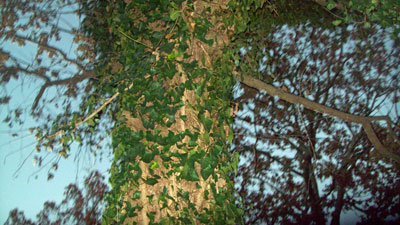

Answer: The only ways that ivy will harm trees are (a) if the vine grows out over the major branches and causes excessive shade or (b) if the leaves become coated in ice, and if the added weight is more than the tree can support. Otherwise, there is no immediate cause for concern. With that admitted, I have to agree with you, in that I wouldn’t want to have all of that excess growth on my own tree. You can merely cut the stems of the ivy at or near the ground line. I would probably cut as many as I could with a pruning saw, but I’d be careful not to cut into the wood of the tree trunk. Where I couldn’t get to them with a pruning saw, I’d use a wide-bladed chisel and just cut the stems in two. Leave the old stems hanging in the tree. You can peel them off, or they’ll gradually dry, decay and fall to the ground.
Question: Several of my Indian hawthorns have this kind of leaf damage. What causes it, and what can I do to stop it? D.C., Midland.
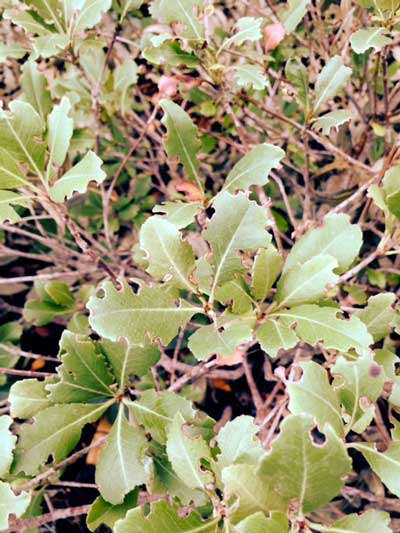
Answer: First guess would have been leaf-cutter bees. They cut almost perfectly semi-circular holes from the edges of plants’ leaves and make their nests from them. There is no spray to control them, since they’re there for only a short time and since they don’t actually feed on the leaves. I’ve never seen them this bad on Indian hawthorns. And, just to have mentioned it, I looked closely to see if I saw any brown spots totally within the leaf blade surfaces. Bacterial leaf spots will often release the dead tissues, leaving foliage filled with circular holes. However, I didn’t see many of these affected spots that were entirely within the leaf surface, so I ruled out the chance of leaf spot.
Question: I visited relatives in Utah in November and discovered Kintzley’s Ghost honeysuckle. Will it grow in our climate where I live? M.C., Snyder.
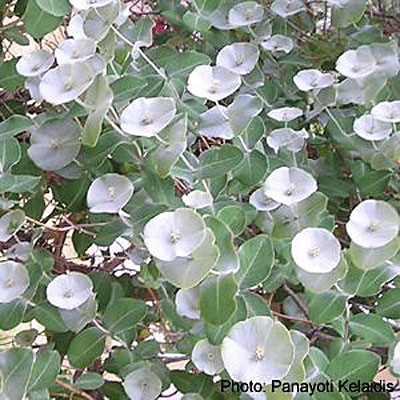
Answer: We are posting the photo you sent to us, but I do note that it is someone else’s, and we give full credit for it to Panayoti Kelakis. I had never heard of this plant until I read your note. However, there are dozens of honeysuckles, both shrub-form and vining, and many of them are either common or worthy of trial in Texas. In looking your plant up online, I came across this story. It may very well be where you found the photo. If not, it may have some information that will help you.
Question: We have not had good luck with hydrangeas in Texas, although in Ohio and Illinois, they were prolific. This is how they looked about a month ago. Should they be pruned now, or do I wait? These had an east exposure. J., North Richland Hills/Keller.
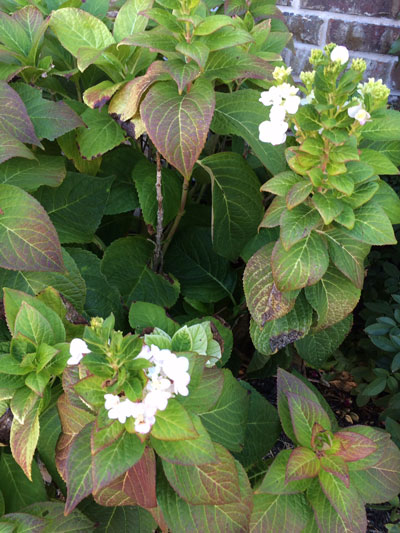
Answer: Hydrangeas do very well in the Piney Woods in East Texas, but the farther west you go from there, the worse they perform. It’s partly because soils aren’t always conducive to them, but it’s also because of the low humidity and high temperatures. They can be pruned extremely modestly now, but any major reshaping must wait until after their spring blooming season. Many of us who live outside their favored area have simply decided that florist-type hydrangeas aren’t our best landscaping choices. (The woody oakleaf hydrangea selections, by comparison, are fabulous for moist, shady areas in DFW, also along I-45.)

